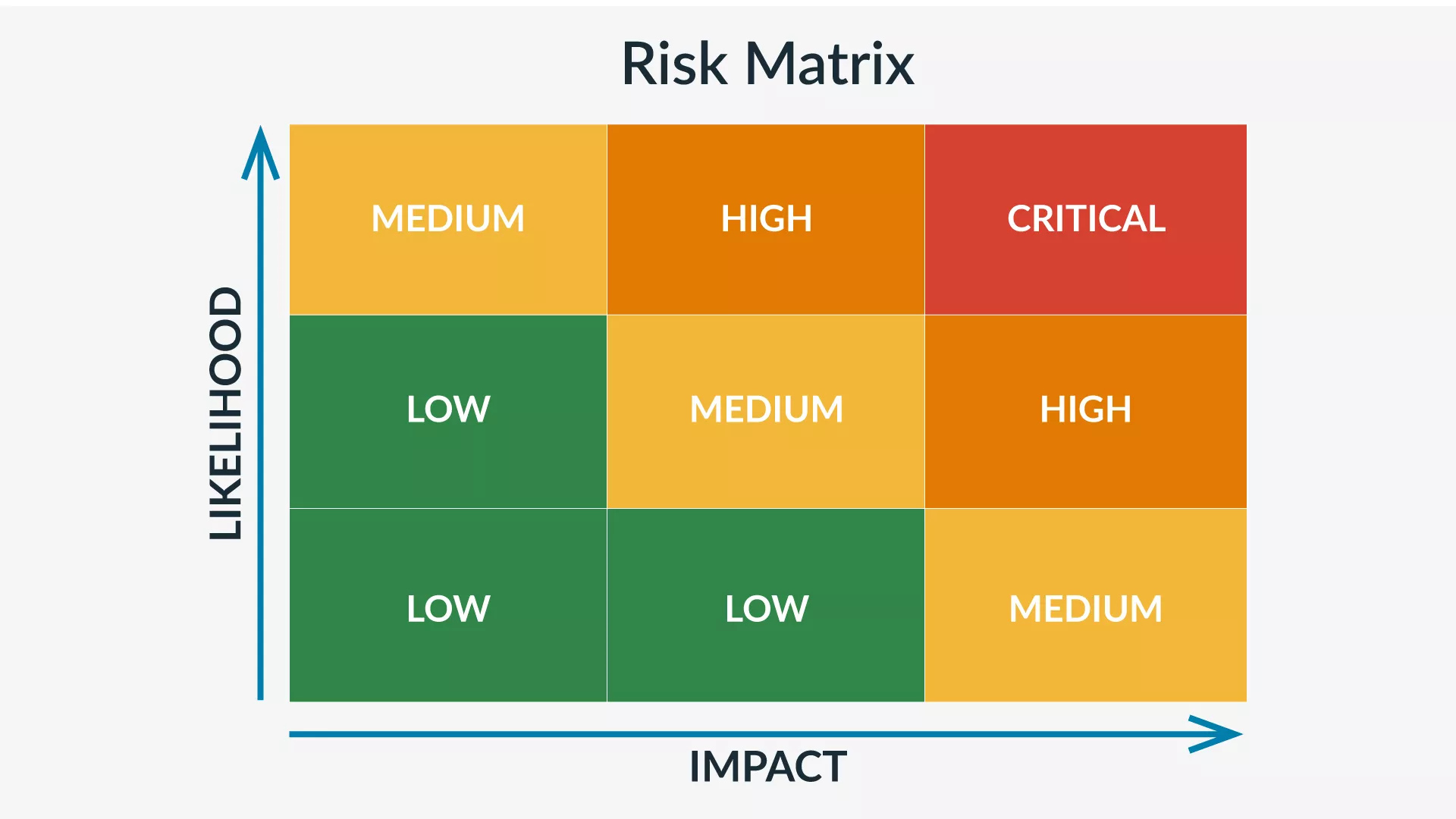
What Is a Business Contingency Plan? How to Protect Your Operations in 5 Steps
Your business faces a variety of threats. Learn how to weather them and keep your operations moving safely and effectively.

Remember the last time your work day went perfectly according to plan, with no disruptions or problems? For most people, the answer is a resounding “no.”
While most hiccups in an average day are inconsequential, businesses constantly face problems that can have a significant impact. And many of those risks can be foreseen, at least in broad strokes, if not with perfect clarity. Companies in Florida know hurricanes are a risk, organizations in the Midwest can expect to face tornadoes, and West Coast businesses have to deal with heat spells and earthquakes. If you’re unprepared, they can derail your operations and put employees at risk. However, with a business contingency plan, your company can be prepared to deal with adverse conditions and keep moving.
In this article, we’ll review how contingency plans fit into your risk management plan, why they’re important, and how to implement them.
Business Continuity Plan Template
What Is a Business Contingency Plan?
Often called a backup plan or “plan B,” a business contingency plan is a set of actions a company can take to respond to a potential disruption. It allows companies to rapidly navigate foreseeable risks and unexpected events, preserving normal operations and minimizing negative impact.
For example, say you’re an e-commerce brand preparing for Cyber Monday sales. You know your online infrastructure will be slammed with heavy traffic, and missing sales due to downtime would significantly impact your bottom line. Several related contingency plans could protect your operations, including:
- Excess server capacity in case traffic is higher than projected
- A backup payment processing gateway in case your primary solution goes down
- Extra customer service resources to handle a spike in questions or issues
- Keeping more IT staff than usual on call to rapidly address any network or hardware disruptions
How Do Contingency Plans Compare to Continuity Plans?
Your risk management strategy includes several types of plans to protect operations. While they’re all complementary, they each serve different purposes. Contingency and continuity plans, in particular, can seem similar—but there is a clear separation:
- Business contingency plans are reactive guidelines designed to address specific circumstances or negative events once they happen. They usually factor into a crisis management plan, prescribing a step-by-step emergency response.
- Continuity plans, on the other hand, are a proactive approach to minimizing potential risks and maintaining critical business functions. They’re part of an organization’s risk management plan and focus on frameworks, strategic planning, and holistic approaches, rather than specific actions.
Why Every Business Needs Contingency Plans
Like any other aspect of resilience management, contingency plans aren’t just nice to have; they’re an integral tool for keeping your business running smoothly and safely.
A contingency plan helps provide:
- Improved business resilience and faster recovery from disruptions
- Reduced potential for financial losses due to pausing operations or incurring damage
- Stronger reputation for being prepared and dependable in any situation
- Greater confidence from employees that they’re equipped to do their jobs safely and effectively
- Compliance with laws and regulations for industries that require backup plans, like those handling hazardous materials
Conversely, a lack of business contingency plans can also amplify the impact of disruptions. At best, operations can grind to a halt, leading to delays. Worse, employees, clients, and vendors may lose faith in your organization’s ability to overcome adversity, leading to longer-term business losses. And without a clear plan, even well-meaning recovery efforts can make a bad situation worse.
Contingency Plan Examples
For any given disruption, there’s a specific type of contingency plan. And there are countless risks across different industries and regions. For example, a long-haul trucking company in the United States faces far different key risks and contingencies than a private security company operating in the Middle East.
Not every contingency plan fits neatly into one category, but here are some common types:
- Business operations: In any industry, companies rely on a combination of equipment and people to maintain normal operations. Plans for disruptions like sick days and broken machinery will keep your business moving.
- Information systems: As businesses increasingly rely on technical resources and require robust cybersecurity, the potential for digital disruptions is massive. Network outages, hardware failures, cyberattacks, data breaches, and other risks can all derail your operations.
- Supply chain: With globalized and just-in-time logistics, many businesses lack supply chain resilience. Planning for supply chain disruptions can insulate your business from vendor and client issues.
- Environmental conditions or natural disasters: Every region is subject to inclement weather and environmental disasters, such as snowstorms, extreme heat, hurricanes, or earthquakes. A solid contingency plan can maximize your ability to operate and recover in any environment, and you should factor it into your disaster recovery plan.
- Public safety: External factors, ranging from protests and civil unrest to disease outbreaks and pandemics, can impact your business. Knowing how to work around them—or when to shut down for safety—will protect your operations and your team members.
- Financial or economic: Your bottom line is under constant threat, from unpaid invoices to economic risks limiting your credit access. A plan can keep you solvent and operating, rather than scrambling for cash.
Key Components of a Business Contingency Plan
Contingency plans come in a variety of shapes and sizes. A Fortune 500 company dealing with hazardous chemicals will probably need more rigor than a regional internet service provider’s data backups. However, when it comes to business contingency plan templates, most will share these core components:
- A risk assessment matrix for prioritizing all covered hazards
- The response strategy and action items comprising the plan
- Roles and responsibilities for developing, maintaining, and executing the contingency plan
- Communication procedures for sharing the plan with stakeholders and providing necessary training
- Trigger points that signal plan activation and what systems supply information, such as your threat intelligence platform
- Testing and review procedures to practice and refine the contingency plan
5-Step Guide to Creating a Business Contingency Plan
Once you’ve identified the people responsible for a contingency plan, building it is a five-step process.
1. Identify, assess, and prioritize risks
Since a contingency plan addresses specific scenarios, it’s important to know what risks your business faces. There are three key elements to risk analysis:
- Identification: What are the risks the business realistically could face?
- Assessment: How likely are the risks to occur, and what is the expected impact?
- Prioritization: Based on both likelihood and impact, which risks are most important to address?
A risk matrix helps you visualize the risks you need to address and enables you to plan for the most critical contingencies.

2. Conduct a business impact analysis (BIA)
Once you’ve identified the risks you want to plan for, a business impact analysis describes what’s at stake. For the sake of contingency planning, this analysis documents several key aspects of your operation:
- The business functions that are subject to risk and those most critical to keep running
- How a given scenario could impact those business functions
- An estimate of the consequences of a risk materializing, be it delays, financial losses, or potential injuries
- Objectives to minimize downtime, accelerate recovery, and resume normal business operations
Measuring a risk’s potential impact helps you decide how much to invest in solutions and helps get leadership on board.
How-to Video: The BIA
This video will help you facilitate an effective business impact analysis at your organization.
3. Create an action plan
The heart of a contingency plan is deciding the course of action your team should take. In most cases, this will mean deviating from standard procedures, but keeping operations moving as much as possible. While developing action plans, you need to balance your team’s safety, business goals, and the potential impact of a given risk.
For example, say you’re the safety officer for a construction company in Missouri. There are a variety of contingencies you should plan for, but the response plans for each will be vastly different:
- One common risk is a tornado warning. In this scenario, the potential safety impact is massive, and immediately evacuating to secure basements makes far more sense than attempting to continue operations.
- Another frequent scenario is rainstorms. In this scenario, you can assess a much more complex set of circumstances. Can your equipment safely run in the rain? Is there enough precipitation to cause a safety risk for your employees? Would minor adjustments in PPE allow your team to continue working?
4. Secure buy-in to the plan
Before implementing a plan, you need to secure several layers of buy-in. Some are more important than others, but missing any of these layers can cause your contingency planning initiatives to fail:
- Business owners and company leadership need to allocate resources to implement the plan and approve of any residual risks involved.
- Project or department leaders have to agree that the plan makes sense in the context of their operations.
- Your legal team should review the plan for regulatory compliance.
- Employees must agree that their tasks are doable and that they can follow through on them.
5. Test and review
Like any safety plan, business contingency plans aren’t static. You need to keep them updated with changes in your operations, equipment, personnel, or environment. There are two key facets to this:
- Testing and practicing the plan: Key stakeholders should gather periodically for tabletop exercises to simulate unforeseen events and walk through the contingency plan.
- Static review: Safety leaders should review the simulation results, suggested changes, and new ideas and integrate them into the plan.
Business contingency plan maintenance is a constant feedback loop. Any time you make changes, you should test them and ensure you’re refining the plan, rather than introducing new risks, complexities, or challenges.
How to Avoid Common Contingency Plan Mistakes
Contingency plans are only helpful if they’re built to be effective. Avoid frequent planning pitfalls to ensure you’re setting your team up for success.
Give stakeholders the context they need
As a security leader, you’re a domain expert and understand the nuances of risk, likelihood, and impact. However, a key part of your job is communicating information in a way that makes sense to other stakeholders. Often, this means moving away from raw data and shaping a report that conveys urgency and importance.
“I had a situation once where we produced a quantitative risk assessment, and we went in and talked to the CEO and said power outage is a number four, and active shooter is a number five. And this guy had an engineering degree and an MBA, and he’s like ‘yeah, that means nothing to me,’” remarked Steven Kuhr, the founder and CEO of Kuhr Group LLC—while discussing his experience sharing effective contingency plans with stakeholders. “I learned that it’s better to have a deep conversation discussing what the risks are, and going in with a narrative that’s digestible, consumable, and that business leaders can understand.”
Maintain your contingency plans
An out-of-date contingency plan is like a locked emergency exit—a well-meaning idea, but extremely harmful. The last thing you want in an emergency is to waste valuable time and resources following obsolete plans.
Updating your contingency plans is a key part of the risk management lifecycle, and you should review every aspect of the plan:
- Are the risks described still the same?
- Have the business impacts changed?
- Are the proposed actions still the best way of minimizing the disruption?
- Have any roles or responsibilities changed?
- Are there any new stakeholders?
- Should you update the training and communication strategy?
Develop contingency plans with appropriate scope and detail
Contingency plans should thoroughly address a specific risk. Often, companies will miss the mark and either develop plans that are overly vague or too detailed.
On the vague end of the spectrum, you’re not giving your team the tools they need to overcome a problem. Leaving out critical steps will force them to improvise, guess, or abandon the plan altogether. Whichever route they choose, they probably won’t achieve maximum success in preserving business processes.
On the other hand, overly detailed plans are a nuisance to maintain and execute. While it’s important to include salient information, excessive instructions will increase the burden of training and risk, causing people to tune out. Focus on describing the necessary steps in an action plan and reviewing the content with stakeholders to ensure it’s appropriately detailed.
Provide ample training on your contingency plan
The best-laid plans are worthless if your team can’t execute them properly. And unfortunately, that’s a frequent problem in many organizations. While risk management teams craft thoughtful contingency plans, there can be a disconnect before those plans reach the people who need them.
There are two key steps to avoiding this common pitfall:
- Thoroughly communicate the contingency plan in a helpful way for the audience. Ensure you’re using the appropriate level of technical jargon, include diagrams or demonstrations where necessary, and translate accurately if you have a multilingual team.
- Provide opportunities for practice. You might not be able to simulate every detail of an emergency, but walking employees through the mechanics of their role will help them respond quickly and effectively to a disruption.
Planning for every risk your company might face is nigh impossible. However, you can foresee and deal with most potential disruptions. With a plan of action for the most likely and impactful hazards, your team will be prepared to protect not just your business, but their health and safety in the face of adversity.
Frequently Asked Questions About Business Contingency Plans
- How do business contingency plans fit into continuity planning and risk management? Business contingency plans are a detailed, reactive approach to specific circumstances. Higher-level strategies, like a risk management plan, will provide the framework and context to drill down into contingency scenarios. While your business continuity plan checklist will describe general strategies for proactive risk mitigation, contingency plans will get into the step-by-step action items for reacting to risks if they materialize.
- How often should a contingency plan be updated? If there are legal or regulatory guidelines for updates, follow those. Otherwise, it depends on the likelihood and impact of the risk. You should review high-priority hazards at least once every quarter and minor issues less frequently. However, it’s important to revisit contingency plans when business circumstances change, such as buying new equipment, changing vendors, or hiring new key personnel.
- Who should be involved in contingency planning? Anyone involved in the work or its results should take part in the contingency planning. This can include employees, clients, vendors, and even government and law enforcement agencies in some cases. Outside parties might not have a say in your company’s actions, but keeping them abreast of your plan will help minimize confusion during an emergency.
- How do you test a contingency plan? While you can’t simulate every condition for a contingency, you can walk through the plan from start to finish. Going through tabletop exercises allows your team to tackle a given scenario from a variety of angles, react according to the plan, and see if you need to make any adjustments or improvements.



![11 Steps to Creating an Effective Emergency Response Plan [+ Template]](https://www.alertmedia.com/wp-content/uploads/2023/10/Blog-Emergency-Response-Plan.webp)
![4 Phases of Emergency Management & How to Build a Comprehensive Plan [+Template]](https://www.alertmedia.com/wp-content/uploads/2021/12/Blog-2022-EmergencyMgmt-Plan.jpg)
